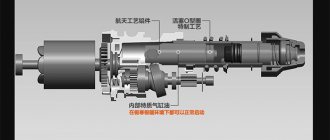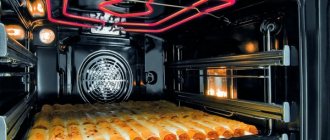What is an inverter microwave oven, how is it different from a regular one? Is it worth overpaying for the benefits promised by consultants? To get to the bottom of the truth, let's understand their structure and find out how a microwave oven with an inverter differs from a simple microwave oven.
Manufacturers claim that such models are much better. Is it true that food cooked in them turns out tastier, more beautiful and retains more nutrients?
Why do you need an inverter?
Even those who do not know physics well understand that in a microwave oven food becomes hot and edible under the influence of ultrahigh frequencies - microwaves. Molecules set in motion by an electromagnetic field release thermal energy. Since the waves are able to penetrate objects through and through, the food in the chamber is evenly heated, not only on the surface, but also inside.
Where do the waves come from in a microwave oven? They are emitted by the magnetron - the “heart” of the device, its main part. In conventional furnaces, the magnetron is powered through a transformer, in these furnaces - from an inverter. This is a control unit and a DC-AC converter. It is in this block that the difference between conventional and inverter systems lies.
Since the inverting element is much smaller than the transformer, there is an advantageous difference in size and weight.
Study of the differences between conventional and inverter microwaves
There are a lot of laudatory words about inverter microwave ovens on the Internet, of which little is clear. There is already a publication on this topic on Muska. Everything about her is not so positive. I decided to figure out this technology myself. And for one thing, see the differences between inverter microwaves and conventional ones. Fortunately, I had stoves of both types, an RF detector board on ad8318 and an oscilloscope. Interesting? Then under cat. To begin with, I supplied 9V power to this RF detector board on the ad8318 chip from aliexpress (the old link unfortunately doesn’t work, but there are plenty of such boards out there). A wire of slightly more than 7 cm in length is soldered to the RF input of the scarf (as it happened).
I connected the oscilloscope. A periodic short noise of rather large magnitude became visible on the oscilloscope. For a long time I could not understand where she came from. Turned off all unnecessary electrical appliances: computer, WiFi router. He took cell phones into the back room. The interference remains. It turned out - from a 9V mains power supply. Changed the source. This is the picture I got on the oscilloscope. For people who have not dealt with an oscilloscope, I will explain. Bottom left, just to the right of the CH1 inscription, the value is 500mV. This is the vertical scale - 500 mV per cell. To the right - Time 5.000ms. This is the horizontal scale - 5 ms per cell. On the left side there is a yellow arrow with the number 1 inside. This is the zero position. From level zero to the top edge of the noise track is a little more than 4 cells. 4 x 0.5 = 2V. Which is very similar to the output voltage of the ad8318 microcircuit in the absence of a signal at the input in accordance with the description - 2.1V. The higher the signal level at the input of the ad8318, the lower the output level.
It is clear that there are interferences and there are many of them. I don't know how to get rid of them. You can, of course, build a filter at 2.45 GHz, or make a shielded camera. But it is difficult. In general, I decided to try to use the equipment as is. The microwave emits a lot. Maybe this way her work will be visible.
To begin with, I decided to experiment with a regular microwave oven - an old Samsung M1736NR.
Power 800 W. Consumption 1150 W. The efficiency is approximately 70%.
I put a glass of cold water in the microwave so that there was somewhere to spend the radiation energy. I placed the detector board next to the stove and pulled out the input wiring - the antenna - along the door. I turned on the microwave at maximum power and got this picture on the oscilloscope. It can be seen that the stove emits pulses with a period of 20 ms (frequency 50 Hz). It's clear where this comes from. A simplified diagram of a conventional microwave looks like this.
After the high-voltage transformer there is a voltage doubler on diode D1 and capacitor C1. For half the period of the mains frequency of 50 Hz, the capacitor is charged through the diode. The other half of the period is discharged through the magnetron, which creates microwave radiation. Moreover, to be honest, it emits less than half a period. At full power, such radiation pulses continue until the time set on the timer expires.
But at lower power the picture changes. Top picture - power 300 W. Lower - 450 W. Microwave radiation is turned on/off with a period of 30 seconds. Do you see such a big stick before the radiation appears? This is interference from turning on the high-voltage part. At the same time, a click is heard in the stove and the hum of the transformer becomes audible. And after that the radiation appears only after 1..2 seconds. Apparently, along with the high voltage, the filament voltage of the magnetron is also turned off. Accordingly, it takes time to heat its cathode. As far as I understand, it is not good to apply high voltage before the cathode has warmed up. But they did so. In addition, it seems that the average power was calculated without taking this delay into account. For example, for 300 W, the radiation switch-on interval should be 30*300/800 = 11.25 seconds, or 2.25 cells. But the actual duration of the radiation pulse is only 2 cells.
With a regular microwave, I think everything is clear. Let's move on to the inverter - Panasonic NN-GD392S.
Power 950 W. Consumption 1150 W. Efficiency - 83%. Noticeably more than a conventional microwave oven. This microwave uses a regular rotating table.
This microwave is also not new. There is a suspicion that it was slightly burnt. One day, food was heated in it so much that the plate on which the food was located burst. The food, naturally, was charred. But the microwave is alive. In general, we will look at what is available.
The power in this stove is not specified in Watts, but in abstract values from the list: high (H), high-medium, medium, medium-low (M-L), defrost (P), low (L). I signed the corresponding pictures with letters in brackets. So, high power. Arrows with numbers mark places that are shown in more detail in the pictures below. Quite an interesting picture. The radiation is switched on by pulses with a period of 10 ms. There is a pause of 2.6 ms between pulses. I assume that the pause occurs when the mains voltage crosses zero. Apparently, the storage capacitor is too large to operate without pauses. There is some kind of fine structure inside these pulses of switched on radiation. First, the radiation is turned on for short intervals of ~2 μs. Then, on the contrary, it turns off for short periods. Then, before switching off for 2.6 ms, short switches occur again. It happens that in the middle of the interval a complete shutdown, even for a short period, does not occur. The level drops only slightly for short periods of time. The stove can work for several tens of seconds as in the top picture, then for some time as in the bottom. Then again like on the top. I didn't find any logic in this.
Next is medium-low power. The duration of the long pause increased to 4.4 ms. The fine structure has also changed a little, but I don’t know how to estimate the average power taking it into account. If we take into account only long pauses, then (10 - 2.6) ms - 950 W, therefore (10 - 4.4) ms - 720 W. I did not find any radiation switch-offs for a time of about 1 s or more at this power.
But in defrost mode and at low power there are long-term switch-offs of radiation. The period in both modes is 22 seconds. In defrost mode, the duration of activation is 12.5 seconds. At low power 10.5 sec. Otherwise, operation in these modes is the same as with medium-low power (pause 4.4 ms).
In general, the advantages of inverter technology are noticeable. Heating at all powers, except defrosting and low, occurs almost evenly over time. However, it appears that the reduction in power from high to mid-low is only 25%. When moving from medium-low power to defrosting, the average power drops almost twice (up to 400 W). And at low average power is 340 W. No wonder the average power in watts is not indicated in the instructions.
The advantages of inverter technology include increased efficiency from 70% to 83% (based on the passport data).
It also seemed to me that the inverter oven does not turn off the magnetron heat until it has worked for the entire specified time interval. Even if the high voltage is turned off. But I didn’t look into this issue in detail. If this is so, then the magnetron resource should be longer. At least if you use the stove carefully.
Operating principle of inverter microwave ovens
The magnetron, generating microwaves, gradually reduces the radiation power. The effect on the molecules becomes softer, which prevents them from overheating.
In conventional stoves, the magnetron does not reduce power, but only shortens the intervals of wave impacts and increases the pauses between them. This is more “traumatic” for the molecules; moisture is lost and the product dries out. In an inverter, due to a gradual decrease in radiation, it is possible to preserve the structure of the molecules. What is the practical interest in this for the consumer? Products retain their shape better, they are more attractive on the outside and healthier on the inside.
The essence of technology
An innovative method of cooking food is proposed - Inverter Combination Cooking. This technique eliminates the disadvantages associated with traditional devices. Microwave ovens cook quickly, but only inverter control makes it possible to brown food. By combining a grill or other functions with an inversion system, you can quickly heat and cook food that is healthy and looks delicious.
Accelerated defrosting
Consumers looking at microwave ovens with an inverting element are wondering what Turbo defrosting means. This is a technology that uses the principle of sequentially varying power. Thanks to Turbo mode, food defrosts twice as fast. The “chaos theory” is used, in which it is possible to distribute the energy of microwaves, alternating in the best way the principles of regularity and irregularity.
External differences
If you compare the external data, a device with adjustable power is no different from a regular one, except that it weighs less. All the differences lie in the principle of operation of the device. Thanks to the absence of a bulky transformer, the developers were able to reduce weight and increase the volume of the camera while maintaining external dimensions.
Electricity consumption
A huge advantage of the system is the economical consumption of electricity. The magnetron, which turns on only once per cycle, gradually reduces power, consuming 28% less energy. If standby mode is turned on, savings reach 72%.
Advantages and disadvantages
Like any technology, a microwave oven with an inverting element has its pros and cons. Advantages:
- Compact: spacious chamber, light weight.
- Uniform heating. The control system allows you to smoothly reduce the impact during the cooking process.
- Large set of functions. Dishes are prepared quickly and at the same time remain healthy. By combining microwaves with a grill, you can cook food with a crispy crust, just like in the oven. Microwave radiation can also be combined with steam and other options.
- Fast defrosting. A number of models have this function and defrost food twice as quickly. Since the intensity of the magnetron changes, defrosting occurs in a soft mode - beneficial substances are not destroyed, freshness is better preserved.
- No turntable. The absence of a plate gives more options for placing the container; one thing is important - that it fits in the chamber.
Experts and users find only one drawback with the stoves in question - the price. They are more expensive than regular microwaves. There are also a limited number of modifications.
Advantages of inverter ovens
In addition to their small size, furnaces with this operating principle have a number of other positive properties:
- Uniform heating. This is achieved thanks to the ability to control the power and gradually reduce it towards the end of cooking. Unlike a conventional microwave, where water in the product repeatedly boils during operation, here all processes occur more smoothly. As a result, the cellular structure is not disturbed, and the prepared dish retains vitamins, microelements and other beneficial properties.
- Multifunctionality. The inverter operating principle allows you not only to quickly prepare a dish, but also to provide it with qualities unusual for a conventional microwave. For example, cook meat or baked goods with a crispy crust. This becomes possible by combining wave action with a grill. You can also combine microwaves with steam and other options.
- Accelerated defrosting. Some models are equipped with this function, which allows you to prepare the product twice as fast. The mode involves alternating the intensity level of the magnetron, due to which defrosting occurs in a more gentle mode, preserving the freshness and beneficial properties of the product.
- No rotating disk. This allows you not to be limited in choosing the shape and size of the container. The main thing is that it fits in the camera.
Attention! Experts and users do not note any technological shortcomings of the device. The main disadvantage is the higher price compared to a conventional microwave and an insufficiently large range of models. .
How much healthier is food from an inverter microwave oven?
The question of the healthfulness of microwave meals has always worried consumers. How true are the claims about the benefits of food cooked in a new type of oven? Any processing negatively affects the usefulness of the products. It is clear that due to the traumatic effects of electromagnetic waves, food loses its original concentration of nutrients - vitamins, minerals, and other nutrients are destroyed.
After repeated experiments and research, experts were able to state that ovens with an inverter operating principle can preserve the content of vitamins and minerals by about 30% more than conventional microwave ovens.
The inverter is an important part of the microwave
Already based on the very name of this device, it becomes obvious that, unlike older models, it contains an inverter.
What is an inverter
First, let's figure out how a microwave oven generally works and what elements it consists of.
The furnace operates through the use of high-frequency radiation, otherwise known as electromagnetic waves. These waves, reflected from the walls of the microwave countless times, pass through the products in it, simultaneously transferring their thermal energy to them. Due to this transmission, food is heated or water is boiled. These electromagnetic waves are generated by a magnetron installed inside the microwave body.
The inverter is an element directly responsible for the operation of this very magnetron. In the very first microwave ovens and their simplest models, this function was assigned to a transformer.
What is the difference between a transformer and an inverter
- The transformer is capable of transmitting only waves of a predetermined power. While working, it transmits short electronic pulses generated by the device at intervals of time predetermined by the set mode. The inverter, in turn, is able to regulate the power of transmitted radiation from higher to lower. Thus, it constantly generates electromagnetic waves, adjusting their strength throughout the entire operating time of the device.
- The difference between an inverter and a transformer also lies in its dimensions and weight - it is much smaller and lighter than its “predecessor”.
The principle of operation of an inverter in a microwave oven
If we consider the principle of operation of an inverter installed in a microwave oven, we should first turn to the operation of a standard microwave oven. When working, a simple microwave uses waves of equal power to heat food, alternating their pulses with pauses. Whatever mode you set on the stove, it will differ only in the duration of exposure to waves and breaks between them. The consequences of such uneven heating, as a rule, are small “explosions” that form due to damage to the integrity of the molecular structure of the product and lead to splashing of food inside the oven. The consequence of such damage is the partial loss of the food’s beneficial properties and taste. The finished product seems blander than expected.
An inverter microwave oven acts on food continuously and evenly, gradually reducing the power of its electromagnetic radiation. This, in turn, makes it possible to set complex cooking modes on the device. The oven is capable of smoothly transitioning from one cooking stage to another, without requiring additional human intervention associated with switching modes or connecting additional options. Products cooked in such an oven not only retain their integrity at the molecular level, but also their aesthetic appearance.
It should also be noted that an inverter microwave oven is much more economical in terms of electricity consumption. The percentage of monthly savings, compared to a conventional appliance, averages approximately 28%.
It follows that despite the external similarity of the basic and inverter models, their internal structure and operating process are fundamentally different.
How to choose
The selection criteria are practically no different from the factors taken into account when purchasing a traditional inverter-free model. Need to evaluate:
- dimensions;
- power;
- capacity;
- control;
- functional;
- price.
You also need to consider the expected intensity of use. To heat up ready-made dishes, 0.6 kW is enough - you can buy a solo stove. With additional functions, the power reaches 1.5 kW.
The capacity of the chamber is 14-20 liters. Large volume is recommended for families of 4-5 people. Capacious microwaves are also useful for partygoers who cook for guests.
When choosing a suitable modification, you also need to pay attention to:
- Control. Typically, models with a large range of options use a touch or electronic option - it’s faster, more accurate and more efficient to configure.
- Protection. If there are kids in the family, take a model with a child lock feature.
- Grill. Its functions can be performed by a heating element or a quartz lamp. In the latter case, the dishes seemed to be cooked over a fire. Some models have a vertical or double grill.
- Internal coating. The best option is ceramics or bioceramics. This is an easy to clean material that does not form carbon deposits. Has high resistance to heat and mechanical stress.
Basics
To begin with, it is logical to give a few fundamental definitions. So, a microwave oven is an electrical appliance for preparing food that uses the effect of heating materials (products) containing water by exposing them to electromagnetic waves in the decimeter range (most often with a frequency of 2450 MHz). Food molecules, liquids, contain negative and positive particles. In the absence of an electromagnetic field, the molecules are oriented in a random order. When cooking, under the influence of an alternating field, the molecules begin to rotate. The friction between molecules creates heat, which cooks food and causes water to boil. Heating of products here, in a microwave oven (it is also called a microwave oven; microwave is ultra-high frequency radiation, in this context - the same as microwave radiation), occurs not only from the surface (from above), but also through the volume of the product containing polar molecules of liquid (water). Radio waves penetrate the product to a depth of about 2-3 cm and are absorbed by it. We especially note that in a microwave oven there is no “heating from the inside” - such a statement can often be heard. No, microwaves come from the outside in. The effect of “internal heating” can occur when products with dry, non-moisture-conducting surfaces are processed in a microwave oven. For example, baked goods with a dried out crust. In them, most of the moisture is concentrated inside. Therefore, heating manifests itself deeper—hence the idea of “heating from the inside.” In everyday life, microwave ovens are used for quickly preparing various dishes, and also often for quickly defrosting or heating food.
A magnetron is an essential element of a microwave oven. It is he who generates electromagnetic radiation, with the help of which food is prepared. The transformer (also part of the furnace structure) provides high-voltage power to the magnetron. Microwaves are fed into the working chamber passing through a waveguide (special channel), which ends in the working chamber with an outlet channel (hole) transparent to radio frequencies. You should not turn on the microwave oven empty, because then the waves will not be absorbed by the product, but will be reflected from the walls of the working chamber, which can ultimately cause sparking. Long-term sparking can damage the magnetron (so if a small amount of food is being cooked in the microwave, it is advisable to put another glass of water in the chamber to absorb microwaves). There are microwave ovens with several waveguides - for a more uniform distribution of microwaves throughout the working chamber. There are also models in which the magnetron is installed at the bottom of the furnace (and not on the side, as in the vast majority of models). In this case, again for better distribution of radiation throughout the oven chamber, the microwave distributor rotates, which can be located in the working chamber from below or above.
Finally, the inverter microwave oven is the main character of this material. The main difference between an inverter microwave oven and a “regular” one is the presence of an electronic control unit for the power of the magnetron (actually, an inverter - a device for converting direct electric current into alternating current). And the lack of a transformer. We will consider details about inverter power control of a microwave oven below. The fact that there is no transformer in the oven allows us to highlight some of this lack of advantages. Firstly, the electronic control unit takes up much less space - because of this, if we compare ovens with the same volume of the working chamber, the dimensions of a non-inverter oven will be slightly larger.
The transformer takes up much more space in the microwave oven and weighs more than the electronic inverter control unit
Who is the manufacturer
The most famous manufacturer of the microwave ovens reviewed is Panasonic.
Panasonic NN-DS596
The described technology is used in the NN-DS596 model, which supports combined mode. Chamber volume - 27 l. Without turntable. There is a powerful steam generator and an upper grill.
Panasonic NN-CD565B
A compact model with a power of 1 kW, not inferior in functionality to full-size versions. Dimensions are reduced due to the special placement of the fan. There is a quartz grill.
Panasonic NN-SD 366 M
Silver-colored stove with a capacity of 22 liters and a power of 0.8 kW. Electronic control. Rotating tray with a diameter of 24.5 cm. Dimensions: 28x48x36 cm.
What Siemens offers
Panasonic is not the only manufacturer of these microwaves; Siemens also produces them. Among the models from this manufacturer, it is worth noting the HF 25M2L2.
Its capacity is 21 liters. The chamber coating is stainless steel. There is defrosting and auto-cooking. Push-button control.
Microwave from Whirlpool
The large AMW 848 IX microwave oven has the most spacious chamber ever: 40 liters. A whole Christmas goose will fit here. The oven has all the functions that a housewife dreams of - grill and convection. Suitable for roasting meat and preparing baked goods. Touch control. There is defrosting and auto-cooking.
Although inverter stoves are produced by a limited number of manufacturers, buyers have plenty to choose from. This technique will be a reliable help in culinary delights.
Advantages of a conventional microwave oven
The issue of supposedly dangerous radiation from microwave ovens has always been relevant. Often people, fearing for their health, denied themselves the pleasure of using this device. To protect their customers, manufacturers have created special nets and improved body protection.
Thus, they ensured that the radiation from the switched on device spreads no further than 20 centimeters.
On sale you can find variations with touch and button controls.
A regular microwave has several advantages that are already familiar to many:
- modern versions of microwave ovens have additional useful functions: steamer, grill and others, as in the Samsung MG23K3575AS/BW. They expand the range of use of the device;
- small size, thanks to which the oven does not take up much space, so it is easy to find where to put it;
- ease of use lies in the automation of work. For example, installed programs already have built-in time and power settings. You don't need to waste time selecting each option;
- Some cooking modes can be added to the software, with which you can prepare certain dishes;
- quick cooking or heating of food will save time without distracting you from your work;
- there is no need to stir the food, add oil - it will not burn, as can happen in a frying pan;
- Child lock is a useful option that allows you to lock the control menu or door;
- The sound signal will not allow you to miss the end of the program. In some models, it can be temporarily turned off so as not to wake up the child, for example.
The cost of microwaves without inverter technology is lower, so you can choose an option for almost any financial opportunity.
Educational article: How does a microwave oven affect a person: 3 reasons not to be afraid
Reviews
Panasonic NN-DS596: Oleg I., Sochi
I was interested in a new approach to cooking. I am satisfied with the purchase. The oven has all the main functions - microwaves, steam, grill, convection and plus combinations thereof. There are many advantages. Very quiet operation - you can barely hear the fan. There is self-cleaning. Food cooks much faster. There are no shortcomings, except for fingerprints that remain on the super glossy surface of the control panel.
Siemens HF25G5L2: Valentina T., Stary Oskol
I spent a long time choosing a microwave, I wanted to find the perfect one. I like that there are a bunch of automatic programs: I set a task, and I’m free - the stove will prepare everything itself. Great power - food cooks quickly. The food tastes good, you can't tell it was cooked in a microwave. I can put my favorite recipes into memory. Beautiful design, has a powerful grill - it comes out just like in the oven, with a crispy crust. Defrosts very quickly.
Using a new approach to power management, inverter microwaves produce tastier and healthier food. The equipment itself loses weight and size - these models are lighter, more compact and more spacious. The only negative is the higher price. But the benefits you get from the purchase are worth it.
Are there any disadvantages to inverter-type furnaces?
At the moment, microwave ovens with inverters have no disadvantages, except for a higher price than classic models. But with the new year and new model, inverters are becoming cheaper. If the difference immediately reached 50%, now there may be a difference of only 10-20% between the two models (for example, the Panasonic NN-GD392S and NN-GT352W models).
If we approach the issue globally, then there is nothing radically new in inverter microwave ovens. This is simply a logical development of household appliance technology - the desire to make it more progressive, and therefore economical, comfortable, safe for people and the product it produces. It's like comparing an electric kettle with a spiral or on a disk - the water will heat up in two kettles, but a modern model without a spiral is more convenient, faster and better.
Yes, the food turns out juicier, healthier, more beautiful. Noticeable savings in electricity and space in the kitchen (a more powerful model will be more compact). They are more convenient to care for - a spacious inner chamber, no plate and access to the internal mechanism (hole under the plate). Inverters have the necessary functions plus their combinations - grill, defrost, heating, steam, convection, and others. They are characterized by quiet operation. New products guarantee the user increased protection from any harmful influences.
Soon, inverter ovens will completely replace models with outdated heating and cooking technology.










